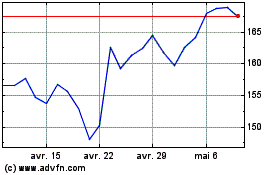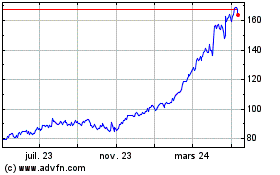Culp assures executives he'll leave the traditional structure
intact
By Thomas Gryta
This article is being republished as part of our daily
reproduction of WSJ.com articles that also appeared in the U.S.
print edition of The Wall Street Journal (October 8, 2019).
When Larry Culp gathered top General Electric Co. officers for a
summit north of New York City last month, the chief executive had a
message for them. He wasn't going to dismantle their company.
They could be forgiven for suspecting otherwise. The industrial
giant had been through tumult, including the pressured departure of
a 16-year CEO, the aborted 14-month stint of his successor, a long
slide in the stock and a gutting of the dividend. A finance chief
teared up in 2017 as he revealed problems that had lain hidden
inside a company once seen as the apex of American manufacturing
might.
Now it had a new CEO, an outsider known for running his previous
company as a collection of independent businesses orbiting a small
central staff.
He put up a slide showing two organizational extremes. On one
end was a top-down, centralized management structure, similar to
the way GE had operated for years. The other end, he said, would be
Berkshire Hathaway's Warren Buffett sitting with just a handful of
staff.
Mr. Culp said he had heard concerns from his lieutenants about
moving GE in the direction of a decentralized corporate structure,
as his predecessor seemed to be doing. Then he said he agreed with
the concerns -- and he wasn't going to do it.
It was the first time Mr. Culp, GE's first outsider boss in its
127-year history, laid out his vision to the executives atop the
conglomerate's power turbine, jet engine and other factories.
He told them he would be streamlining the operations at GE and
shrinking its bureaucracy. The 300,000-employee company had seen
its corporate layer balloon to 26,000 by the time Mr. Culp first
joined as a board member in 2018. So far, he has moved about half
of those corporate-level people into individual businesses and is
giving the business units more autonomy.
Yet, according to people familiar with the meeting, he said he
saw a significant role for a refocused corporate operation at the
industrial giant, leaving intact the structure that stretches back
to its 19th-century beginnings. Though headquarters will be
smaller, it will continue to oversee capital allocation, talent and
technology.
In short, Mr. Culp's plan is to fix GE instead of breaking it
apart, as some people inside and outside the conglomerate expected.
And in doing so, he is treating GE like any other company -- hiring
from the outside and importing management strategies. The question
is whether his deliberate approach will be enough to address GE's
big problems.
At the early-September conference, held at GE's leadership
academy in Crotonville, N.Y., Mr. Culp urged executives to be
candid about problems they encountered. It was an implicit
repudiation of the culture of optimism that insiders say defined GE
under former longtime CEO Jeffrey Immelt, which was dismissed by
some as "success theater." Mr. Culp has said he doesn't want
executives contorting to meet financial goals or please bosses.
From Mr. Immelt's mid-2017 resignation until a year ago, John
Flannery, a 30-year company veteran, led GE. The board approved Mr.
Flannery's plans to sell off the company's century-old locomotive
division, exit the oil and gas business and spin off the
health-care unit. Mr. Culp, named CEO in place of Mr. Flannery on
Oct. 1, 2018, largely stuck to that outline in his first year,
except he kept the part of health care that makes hospital
equipment and sold the biotech part to the company he previously
ran, Danaher Corp.
He has made other moves to reduce debt. On Monday, GE said it
would freeze its U.S. pension plan for about 20,000 salaried
employees and make other moves that would cut its net debt by up to
$6 billion.
One thing that hasn't changed much is GE's depressed share
price. The stock, which traded around $14 when Mr. Culp took over
and fell to near $6 in the market slump last December, has
languished below $10 for much of this year. The company's market
value has shriveled to roughly $75 billion from nearly $600 billion
in 2000.
While company veterans still run major business units, Mr. Culp
has hired outsiders for human resources, investor relations and the
digital business. He has said he would hire a new finance chief,
also expected to come from the outside. Surrounding himself with
new advisers, he fired longtime bankers who had overseen major
acquisitions in the power-turbine and oil markets that proved
disastrous.
He has continued to revamp the board, which before Mr. Culp's
tenure blessed the ill-fated deal-making as well as tens of
billions of dollars in stock buybacks performed when the shares
cost far more than they do now. Seven of the current 10 directors,
including Mr. Culp, have joined in the past three years.
Some of the moves are typical for an outside CEO coming to a
troubled company, but they run against GE's tradition of
cultivating its own talent.
The new CEO is bringing new tools for the job, such as his
adherence to lean-manufacturing practices, developed at Toyota
Motor Corp., which center on an approach known as kaizen. The
system focuses on seeking continuous improvement through in-depth
sessions to assess employees' progress. GE itself, In its glory
years, was considered the lodestar of management excellence.
Danaher, which Mr. Culp ran from 2001 to 2014, and which is far
smaller than GE, was among the first U.S. companies to adopt
lean-manufacturing practices, in the 1980s. That was a decade
before GE's celebrated former chief Jack Welch deployed Six Sigma,
another process-improvement system.
Now Mr. Culp has begun rolling out Hoshin Kanri, a Japanese
strategic-planning process that is part of lean manufacturing.
Hoshin Kanri holds that all workers should understand the company's
strategy and how their role can contribute to it, enabling feedback
and improvement to come up from lower levels.
Such programs seek to find small adjustments that will add up to
large change over time. They are an approach that might expose
lackluster operations, such as when Mr. Culp found that GE was
spending over $100 million a year on premium shipping services to
compensate for delays in getting orders out of factories on
time.
"The ironic thing is that most of what he has to do is
re-instill the cultural and managerial attributes that GE was
justly famous for until recently," said Martin Sankey, a senior
research analyst at investment-management firm Neuberger Berman,
which owns about two million GE shares.
Mr. Culp has increased oversight of GE's divisions, requiring
formal monthly reviews and encouraging daily management of
operations to get away from the end-of-quarter rush to make
financial targets. Earnings per share, once the most important
metric at GE, are viewed as a result that comes from managing the
operations.
At GE's Boston headquarters these days, there are constant
reminders a newcomer is in charge. For one thing, the CEO often
isn't around. He drops in on manufacturing plants, sometimes alone
and without warning, where he walks the floor to size up employees
and how they work.
Mr. Culp -- full name Henry Lawrence Culp Jr., and 56 years old
-- recently gathered top executives at GE's main power-division
plant in Greenville, S.C., for a weeklong teach-in on manufacturing
practices. The work led to streamlining inventory for part of the
assembly line for natural-gas turbines.
In May, he took GE Vice Chairman David Joyce, the leader of the
aviation business, to observe FedEx Corp.'s midnight sorting
process in Memphis, Tenn. The goal was to understand how GE's
aviation business fits into the operations of a customer.
Separately, Mr. Culp discovered a weekslong gap between the time
GE's Aviation division completed work and when its customers were
billed, he told investors earlier this year. He said GE has cut the
gap by a third.
Mr. Culp has spent much of the past year focused on the power
division, a $27 billion business that has been at the core of GE's
financial and operational problems. Saddled with excess gas-turbine
inventory after misjudging demand several years ago, the unit has
burned through billions of dollars as sales slid.
The power business is working through poorly structured deals
that were signed to grab market share. And securities regulators
are investigating how the division accounted for service contracts
and a $22 billion write-off related to the 2015 acquisition of
French company Alstom SA's power business.
In one of his first moves, Mr. Culp split the power division,
separating the gas-turbine and services division from the rest. He
has merged smaller operations into bigger ones, cut a thousand jobs
this year and pushed leaders to continually hone processes.
He wants GE to sign deals with better economics even if this
means passing on some business, and to make sure it delivers on the
agreements, such as by avoiding missed deadlines and penalties. He
has said it will take years to turn around the power division's
performance and work through its backlog of troubled contracts.
An internal probe two years ago found that in at least two
quarters, GE recorded sales of mobile power turbines to a customer
in Angola before they were transferred, according to people
familiar with the investigation. It found that nearly $100 million
of sales had been prematurely booked, usually just as a quarter was
ending, and needed to be moved to different periods, one of the
people said.
The accounting adjustments weren't disclosed because they were
deemed immaterial to a company with well over $100 billion in
annual revenue, according to those familiar with the review, who
added that the probe prompted changes to accounting policies.
Among executives questioned by internal investigators was Scott
Strazik, the CEO of the Gas Power division. Through GE, Mr. Strazik
declined to comment.
In late July, GE raised its cash-flow projections. Executives
said the power business wouldn't burn through as much cash as
feared.
The next month, the company faced an attack by Harry Markopolos,
an accounting expert working with a hedge fund short seller. Mr.
Markopolos's group issued a lengthy report questioning several
aspects of GE's accounting and claiming it was short on working
capital, sending its shares plunging 11% in a day.
Mr. Culp struck back, calling Mr. Markopolos's analysis flawed
and accusing him of market manipulation. GE said it was confident
its accounting was proper. Several major investors and Wall Street
analysts said they agreed with GE. The stock has recovered much of
the loss.
Ken Langone, a co-founder of Home Depot and former GE director,
lauded Mr. Culp's approach as similar to Mr. Welch's and said he
was impressed that Mr. Culp bought GE shares for his own account
after the Markopolos report knocked their price down.
His "priorities are spot-on," said Mr. Langone, who added he
recently bought GE shares for the first time in 14 years.
It may take time for other investors to bet on GE again.
Financial advisory firm Medley & Brown LLC in Jackson, Miss.,
is the sort of outfit that once would have had GE's stock in every
client portfolio because of its reliability and dividend.
Now it doesn't own any GE shares for client accounts, said
Julius Ridgway, a financial adviser at the firm, and few clients
ask about the former blue chip. "Nobody sits around and wonders why
I don't own something that has lost that much value," he said.
Write to Thomas Gryta at thomas.gryta@wsj.com
(END) Dow Jones Newswires
October 08, 2019 02:47 ET (06:47 GMT)
Copyright (c) 2019 Dow Jones & Company, Inc.
GE Aerospace (NYSE:GE)
Graphique Historique de l'Action
De Mar 2024 à Avr 2024

GE Aerospace (NYSE:GE)
Graphique Historique de l'Action
De Avr 2023 à Avr 2024
